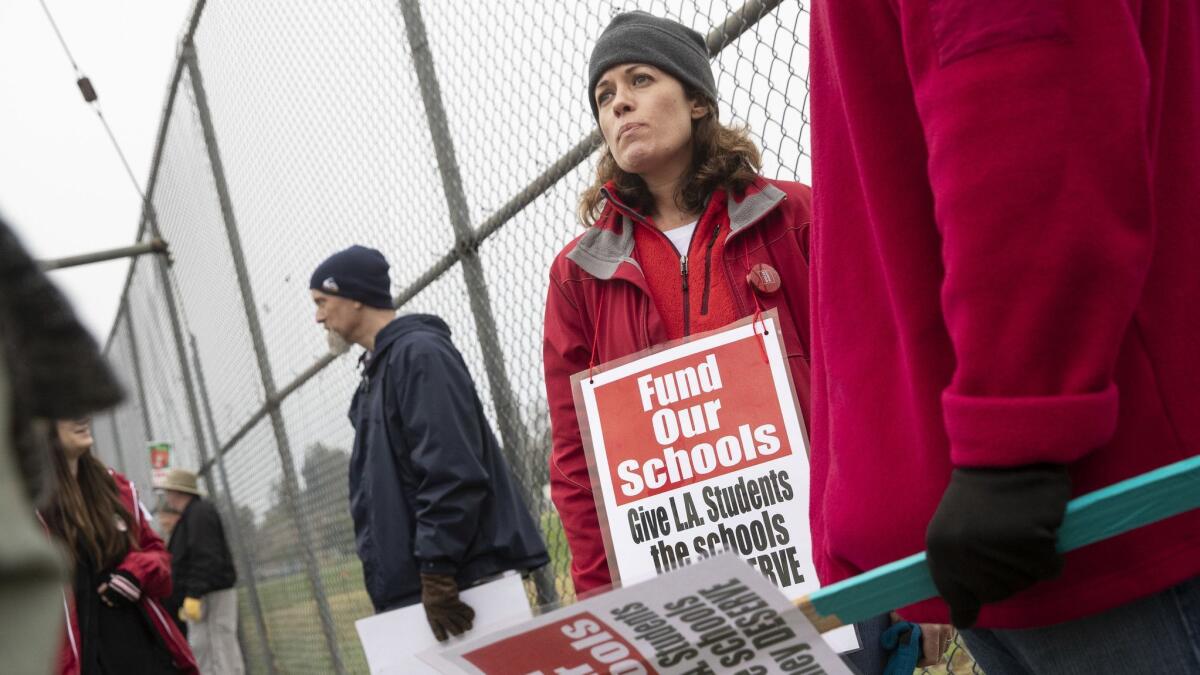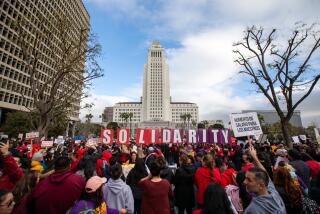Op-Ed: Why the L.A. teachers’ strike may end with a lot less pain than the government shutdown

- Share via
Spectacular failures of negotiation have dominated the news this week. Los Angeles Unified School District teachers are on strike because their union, United Teachers Los Angeles, and the district cannot agree on a contract. And the federal government remains partially shuttered because of the inability of President Trump and congressional Democrats to agree on funding for a border wall.
The causes of the bargaining breakdowns are similar, but the prospects for resolution are starkly different. The teachers’ strike could be settled without total capitulation of one of the sides; the shutdown, probably not.
First, the similarities. In L.A. and Washington, the costs of being at a bargaining impasse are so substantial for both sides that, objectively speaking, each party would be better off with an agreement on the terms proposed by the other, not to mention a range of possible compromises, than they are with no agreement.
Few teachers can go without pay for long, and the district has offered a decent 6% salary increase and some staffing concessions. On the district side, L.A. Unified is losing millions of dollars in state funding every day of the strike, which it could be putting toward priorities the teachers demand.
The strike and the shutdown began, and continue, because each party believes it can bear the suffering longer, with less discomfort than their adversaries.
As much as Democrats detest the border wall, $5.7 billion isn’t much money in a federal budget of nearly $4.5 trillion, and it won’t even build much wall. In the White House, Trump talks a lot about a wall but hasn’t shown much interest in actually building one. Meanwhile, the shutdown means many services deeply important to Democrats and Republicans go unprovided, and workers go unpaid.
If deals favoring either side of these disputes would be better for both than no deal at all, why are L.A. teachers on picket lines and national park rangers on furlough? The strike and the shutdown began, and continue, because each party believes it can bear the suffering longer, with less discomfort than their adversaries. This belief, in turn, convinces each that the other side will concede first, and the benefits gained will be worth short-term costs.
Only one side can be correct in its belief that it can better withstand the pain of an impasse, of course. And if the side that is wrong about its staying power doesn’t realize it quickly enough, even the side that is right may lose more in the intervening time than it will ever recover later.
In L.A. at least, a mutually acceptable resolution ought to be possible. Although there are real differences of principle between the union and the district (over support for charter schools, for example), they’re mostly stuck because of conflicting predictions about the future.
The union wants things that cost a lot of money — smaller class sizes and more counselors, librarians and school nurses — that the district says it also wants but simply cannot afford going forward. Pointing to a current $2-billion district surplus, the union expects a bright financial future. The district sees only storm clouds, in the form of rising costs of retirement contributions and declining enrollments that will cause reductions in state funding.
Disputes rooted in divergent predictions can be resolved with contingent agreements, in which both sides get what they want if their predictions turn out to be accurate. LAUSD should agree to spend a percentage of every future dollar in excess of its dire budget projections on the union’s priorities. The union should agree to forgo its demands if in the future the district is as close to insolvency as it claims it will be. Neutral auditors can verify the financial situation.
Because both sides have complete faith in their foresight, each should be confident that a contingent agreement will vindicate their demands.
Resolution in Washington will be harder to attain. Before the shutdown, it seemed that classic “logrolling” techniques could resolve a typical budget dispute: One side would concede on the wall in return for something else that it valued. Trump might have traded the Democrats a path to citizenship for “Dreamers” in return for wall funding. Or he might have sacrificed the wall in return for Democratic support of other border security priorities. (Trump accepted and then rejected such an offer.)
Enter the Fray: First takes on the news of the minute »
But such tradeoffs aren’t possible when, as we’re seeing now, what both sides want most is to vanquish the other. The consequence is that the shutdown is likely to end only after extreme pain, when one side’s faith that it can better bear the impasse is eventually vindicated.
Trump’s narcissism is a decided advantage in this type of bare-knuckle battle of wills. So far, Democrats have been united, but when food inspection grinds to a halt, airport travel is seriously hampered and unpaid federal employees are evicted because they can’t pay rent, Nancy Pelosi and company are likely to decide that squandering a few billion dollars is a moral imperative, even if it means having to watch Trump declare victory. Those suffering from the shutdown are Trump’s constituents too, of course, but he is unlikely to care as much.
The opposite outcome is also possible, however. If the shutdown deeply impedes economic growth, as some signs are beginning to suggest, or sets off a recession, Trump could experience enough pain to concede first. Presiding over a robust economy is perhaps as important to him as maintaining his image of being tough on illegal immigration.
The teachers’ strike has the potential to end with a handshake at least. Smiles are even possible if the city or the state can find some extra funding to sweeten the district’s pot. It is hard to envision a similar end to the shutdown.
Russell Korobkin, a professor of law at UCLA, is the author of the leading negotiation textbook “Negotiation Theory and Strategy.”
Follow the Opinion section on Twitter @latimesopinion and Facebook
More to Read
A cure for the common opinion
Get thought-provoking perspectives with our weekly newsletter.
You may occasionally receive promotional content from the Los Angeles Times.









